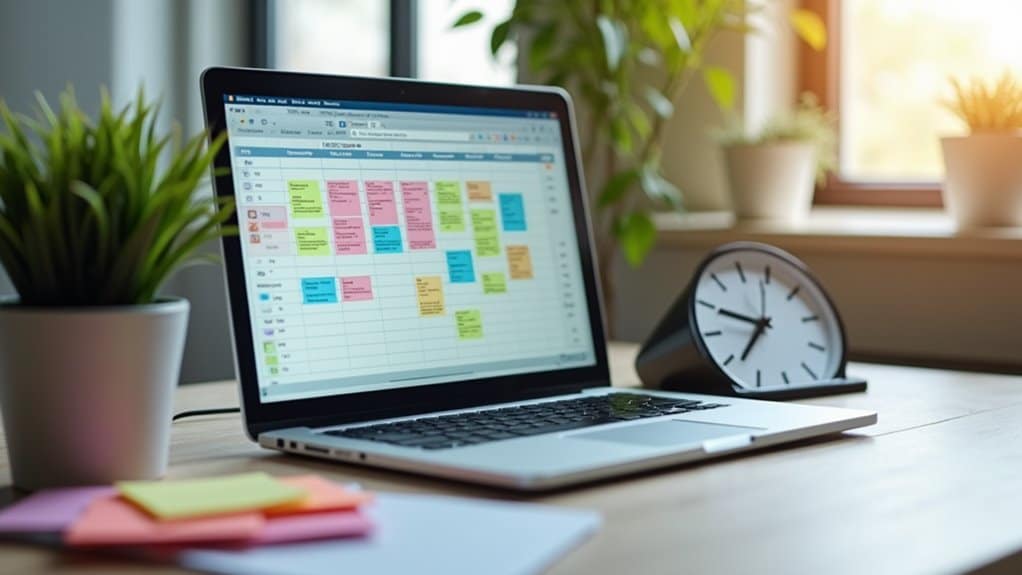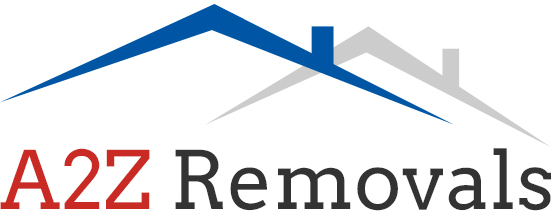
How to Move Efficiently During a Busy Work Week
To move efficiently during a busy work week, start by crafting a detailed schedule outlining your tasks. Set clear, achievable goals using the SMART framework to maintain focus. Prioritise tasks based on urgency and importance with tools like the Eisenhower Matrix. Use time blocking to allocate specific periods for similar tasks, reducing distractions. Remember to schedule regular breaks to recharge. Utilise productivity apps to keep everything organised, and consider delegating or outsourcing non-essential tasks. Lastly, establish boundaries to distinguish between work and personal life. Explore further strategies to fine-tune your routine.
Key Takeaways
- Create a detailed weekly schedule with clear priorities to stay organised during hectic days. For example, list your tasks in order of importance to help you focus on what matters most.
- Use time blocking to assign specific slots for high-priority tasks. This approach helps minimise distractions and keep your concentration sharp.
- Employ task batching by grouping similar tasks together. For instance, if you have several emails to respond to, tackle them in one dedicated session to reduce context switching and boost overall productivity.
- Schedule regular breaks to recharge and maintain focus. Techniques like the Pomodoro method, where you work for 25 minutes followed by a 5-minute break, can help structure your work sessions effectively.
- Set clear boundaries between work and personal time. This helps maintain a healthy work-life balance and prevents burnout. For example, establish a cut-off time in the evening when work stops, allowing you to enjoy your personal life.
Create Detailed Schedules
Creating detailed schedules is crucial for boosting productivity during a busy work week. Start by identifying task dependencies; understand which tasks need to be completed before others. Break larger projects into smaller, manageable tasks using a Work Breakdown Structure (WBS). This method allows you to visualise the order of activities and allocate specific time slots for each task. Additionally, being well-organized during your work week can help reduce the stress associated with house removals.
Next, develop a project calendar. Organise tasks chronologically with clear start and end dates. A Gantt chart can be particularly useful for visualising your project timeline. Be aware of who manages the schedule, and remember to monitor and adjust it throughout the project.
For effective time management, utilise techniques like time blocking. Set aside specific blocks of time for tasks and minimise distractions by following a consistent routine. Digital calendars or planner apps can assist you in staying organised.
Don't forget to schedule breaks to recharge and avoid burnout.
Set Clear Goals
Setting clear goals is vital for managing a busy work week effectively. By defining what you want to achieve, you create a roadmap for your daily actions. Use the SMART framework to ensure your goals are Specific, Measurable, Achievable, Relevant, and Time-bound. This approach clarifies your objectives and strengthens your commitment. Additionally, achieving 3 goals daily builds momentum toward larger objectives. Furthermore, you may want to consider researching removal companies if your goals include moving during this busy time.
To maintain focus, break larger goals into smaller, actionable tasks. Consider finding an accountability partner who can offer support and motivation. Regular check-ins can help you stay on track and adjust your goals as necessary.
Here's a simple table to illustrate the key principles of effective goal setting:
| Principle | Description |
|---|---|
| Commitment | Desire drives motivation to achieve goals. |
| Clarity | Specific goals lead to better follow-through. |
| Challenge | Goals should be challenging yet attainable. |
| Complexity | Avoid overly complex goals that hinder progress. |
| Feedback | Immediate feedback improves goal setting.
Prioritize Tasks

Many people find that prioritising tasks is crucial for managing a busy work week effectively. Start by assessing the urgency and importance of each task. The Eisenhower Matrix can help you categorise tasks into four quadrants, highlighting what requires immediate attention.
Next, use the MoSCoW method to classify tasks as Must do, Should do, Could do, and Won't do. This ensures you focus on the most critical activities first. Additionally, consider applying the principle of decluttering before moving to streamline your workload by eliminating tasks that no longer serve your goals.
You might also consider the ABCDE method, where you assign letters to tasks, with A representing high priority. Breaking larger projects into smaller, achievable tasks can make them more manageable.
Regularly reviewing your task list allows you to adjust priorities as needed. Utilising scrum prioritisation can help you understand task dependencies, enabling you to sequence your work efficiently.
Remember to eliminate non-essential tasks to declutter your schedule. Finally, consider employing a priority matrix or colour coding to visually distinguish high and low-priority tasks.
Use Time Blocking
Time blocking is an effective strategy that can transform your workweek by helping you dedicate specific time slots to particular tasks. By using this technique, you can identify tasks and prioritise them effectively, leading to improved productivity.
Here's how to make the most of time blocking:
- Strategic Scheduling: Break your day into blocks for different tasks, ensuring you allocate time for high-priority activities. For instance, you might set aside 9-11 am for focused work and 2-3 pm for meetings.
- Day Theming: Assign entire days to similar tasks. For example, you could dedicate Mondays to admin work and Tuesdays to project planning, which allows for deeper focus and fewer distractions.
- Adaptive Planning: Regularly review your time allocation and make adjustments based on your productivity. If you notice that certain tasks take longer than expected, tweak your schedule accordingly. Time blocking can enhance your focus by dedicating time to specific tasks, facilitating a flow state that maximizes efficiency.
To get started, list your tasks and assign priority levels. Be realistic about your time slots, taking into account how long tasks typically take. This method not only enhances your flow but also reduces multitasking.
Keep in mind that flexibility is important; be prepared to adapt your blocks when unexpected changes occur. With effective time blocking, you'll gain greater control over your workweek, improve your prioritisation skills, and feel more accomplished.
Schedule Regular Breaks

Regular breaks are vital for keeping your productivity up during a busy workweek. By scheduling breaks in line with your natural rhythms, you can significantly boost your focus and energy. Aim for short breaks every 75-90 minutes, lasting around 5-15 minutes. This not only helps prevent burnout but also refreshes your mind, allowing for better information retention. Brain performance improves with periodic rest, making it essential to incorporate breaks into your routine.
Here's a simple guide to scheduling your breaks:
| Break Technique | Description |
|---|---|
| Pomodoro Technique | 25 minutes of work + 5-minute break |
| 52:17 Method | 52 minutes of work + 17-minute break |
| 90-Minute Blocks | Work in 90-minute increments |
| Non-Work Activities | Engage in activities like walking or stretching |
| Pre-planned Breaks | Schedule breaks to avoid extending them |
Plan your break activities ahead of time to ensure you return to work feeling refreshed. Use timers to manage your break duration, helping you transition back to your tasks smoothly. By adopting these strategies, you'll enhance your productivity while looking after your well-being.
Emphasize Single Tasking
Focusing on one task at a time can significantly enhance your productivity during a hectic work week. By prioritising single tasking, you'll gain clearer thinking and concentrated energy, allowing you to manage your responsibilities more effectively.
Here are three notable benefits of this approach:
- Reduced cognitive load leads to increased productivity and less wasted energy.
- Enhanced focus results in higher quality work.
- Lower stress levels contribute to improved overall well-being.
To practise single tasking effectively, try these strategies:
- Break tasks into smaller, manageable parts that suit your schedule.
- Allocate specific time slots for each task to help maintain concentration.
- Implement techniques like the Pomodoro method to work in focused bursts.
Limit Multitasking

To improve your efficiency, minimise multitasking and concentrate on one task at a time.
This method sharpens your focus, enabling you to produce higher-quality work instead of merely ticking off tasks.
For instance, if you're writing a report, dedicate your full attention to that rather than switching between emails and social media.
Enhanced Focus Benefits
During a hectic work week, limiting multitasking can significantly improve your focus and productivity. By dedicating your attention to one task at a time, you can enter a flow state where your performance is at its best.
Here are some key benefits of enhanced focus:
- Increased Productivity: Fully engaging with your tasks can double your output and enhance the quality of your work.
- Mental and Emotional Benefits: Fewer distractions lead to reduced stress and frustration, creating a more peaceful work environment.
- Goal Achievement and Efficiency: Focused work periods enable you to meet your goals more effectively.
To maximise your focus, try these techniques:
- Prioritise tasks based on their urgency and importance.
- Set up a distraction-free workspace to maintain your concentration.
- Implement methods like the Pomodoro Technique to keep your attention sharp.
Quality Over Quantity
Many professionals overlook the importance of prioritising quality over quantity in their work. By focusing on delivering high-quality results, you enhance your professional reputation and increase job satisfaction.
Start by establishing clear quality benchmarks for each task. Use productivity tools like Wrike or Trello to manage your workload effectively, breaking larger tasks into smaller, manageable parts to ensure they meet quality standards.
Regular quality assessments are crucial. Gather client feedback to measure satisfaction and identify areas for improvement. Keep an eye on your performance metrics to stay aligned with your quality goals, and avoid multitasking, which often leads to lower-quality output and increased stress.
Rather than rushing to complete numerous tasks, focus on high-priority items that demand your attention. This strategy reduces rework and minimises stress, as you're less likely to make errors.
Batch Similar Tasks
Batching similar tasks can significantly boost your productivity during a hectic workweek. By grouping tasks together, you reduce context switching, which helps maintain focus and lowers mental fatigue. This approach enables more efficient use of your resources.
Here are three main benefits of task batching:
- Increased Productivity: Completing similar tasks in focused groups can lead to quicker results.
- Better Time Management: Designate specific time slots for each group, enhancing your schedule.
- Reduced Stress: Avoid the chaos of a disorganised workload, making your path to success clearer.
To implement task batching, start by categorising your tasks into groups such as emails, admin work, and creative brainstorming. Use tools like Notion or Trello to organise these groups and prioritise them.
Set aside dedicated time blocks for each type of task, and use timers to help stay focused.
Regularly review your batching methods to ensure they're effective. By aligning your resources and grouping tasks wisely, you'll find your workweek is more manageable and productive.
Optimize Meeting Durations

Optimising meeting durations is crucial for maintaining productivity during a busy work week. Start by setting clear objectives and a concise agenda, sharing it in advance. This keeps discussions focused, enhances efficiency, and ensures clarity in decision-making.
Limit the topics to keep everyone engaged and cover all necessary points without going off track. Restrict attendance to only those who are essential. Aim for meetings to last no longer than 30 minutes; this keeps attendees relevant and maintains their attention.
Longer meetings can lead to fatigue and reduced productivity, so adhere to scheduled start and end times. Implement effective meeting management by appointing a facilitator and a scribe. These roles help guide discussions and minimise distractions, keeping the conversation on point.
Use engagement strategies, such as quick "temperature checks" during longer meetings, to identify when breaks are needed. Lastly, remember that shorter, more frequent meetings can often be more effective than lengthy, sporadic ones.
Designate Meeting-Free Days
Designate Meeting-Free Days
While effective meetings are important, implementing designated meeting-free days can significantly boost your productivity during a hectic work week. Research shows that introducing just two meeting-free days can lead to a remarkable 71% increase in productivity.
Here are some key benefits:
- Reduced stress: With fewer meetings, you'll feel less overwhelmed.
- Enhanced autonomy: You'll have greater control over your tasks.
- Improved employee satisfaction: A happier team tends to be more productive.
To establish your meeting-free days, consider choosing Wednesdays, as they often work well.
Clearly communicate this change to your team to set expectations and ensure everyone understands the new approach.
Document the benefits and guidelines for optimising these days effectively.
Leverage Productivity Apps

Leveraging productivity apps can significantly improve your work week, making it more organised and efficient. First, identify your specific needs: are you looking for task management, project management, or time tracking? Once you have clarity, select the appropriate tools.
For team communication, consider using Slack or Zoom. If you're managing complex projects, Asana or Monday.com can help simplify processes. For personal task management, Todoist or Microsoft To Do offer user-friendly solutions.
Tools like Trello provide a visual way to manage tasks, while Todoist's prioritisation features help you concentrate on what's important. Evernote is excellent for managing notes across devices seamlessly.
Time management is also crucial. Toggl and RescueTime allow you to monitor how you spend your time, ensuring you stay on track with deadlines.
Additionally, scheduling apps like Doodle can help streamline meetings and reduce the back-and-forth of emails.
Delegate and Outsource Tasks
After enhancing your workflow with productivity apps, it's time to focus on delegating and outsourcing tasks to boost your efficiency. By employing effective delegation and smart outsourcing strategies, you can offload responsibilities and concentrate on what really matters.
Here are some essential steps to consider:
- Assign tasks based on skills: Align tasks with your team members' strengths and interests to improve engagement. For instance, if someone excels in graphic design, assign them visual projects.
- Provide clear instructions: Be explicit about your expectations, deadlines, and the significance of each task to minimise confusion.
- Start small with outsourcing: Begin by outsourcing simple, repetitive tasks, such as data entry, to build trust and confidence in the process.
By following these strategies, you empower your team and free up your time for core responsibilities. Trust your employees to take ownership of their tasks and encourage open communication.
Always check back to ensure tasks are completed as expected and offer constructive feedback to help them grow.
As trust develops, gradually increase the complexity of tasks. Remember, effective delegation and outsourcing not only boost your productivity but also foster a collaborative and motivated work environment.
Set Boundaries for Tasks

To work efficiently, it's essential to set clear boundaries for your tasks.
Learn to say no to extra commitments that don't align with your priorities, and establish limits on how much time you spend on each task.
For instance, if you have a report due, allocate a specific time slot to focus solely on that.
This strategy not only sharpens your focus but also safeguards your well-being during a hectic work week.
Learn to Say No
Your ability to say no is crucial for managing your workload and priorities. By practising assertive communication and setting boundaries, you ensure your efforts align with your goals without overcommitting.
When assessing requests, consider:
- Your current workload and priorities.
- The importance and urgency of the task.
- How it may affect your existing deadlines.
If you choose to decline a task, do so clearly and respectfully. Be direct about your limitations and avoid apologetic language.
Here are some strategies to communicate effectively:
- Suggest alternative solutions or recommend someone else who might assist.
- Set clear expectations regarding your availability for future assistance.
- Keep communication open and honest to foster trust.
For example, if a colleague asks for help on a project that conflicts with your own deadlines, you might say, "I can't take this on right now due to my current commitments. However, I recommend speaking to Sarah, as she's experienced with this type of task."
This way, you maintain your boundaries while still being helpful.
Define Task Limits
Setting boundaries for tasks is crucial for effective time management and productivity. Defining clear task limits helps control the number of tasks in progress, preventing overload and allowing you to concentrate on what really matters.
Begin by prioritising your tasks. Identify the most important ones and set a maximum number to tackle at any one time. This approach helps you avoid multitasking, minimises errors, and enhances the quality of your work.
Using a visual tool, such as a Kanban board, can effectively track your task limits.
Regularly assess your workflow to identify bottlenecks and areas needing improvement. Adjust your task limits based on team capacity and project demands, ensuring you remain flexible without compromising productivity.
Maintain Work-Life Balance
Balancing work and personal life can be challenging, but setting clear boundaries is vital for maintaining that balance. It's important to communicate these boundaries to your colleagues, managers, and family to ensure everyone respects your time and commitments.
Here are some effective strategies to reinforce your boundaries:
- Set Clear Limits: Determine what's acceptable in your work and home life. For instance, decide on specific work hours and stick to them.
- Engage in Transition Activities: Take part in activities like exercise or hobbies that help you switch from work mode to personal time. A short walk or reading a book can be effective.
- Be Flexible: Be open to adjusting your boundaries when unexpected situations arise, but don't compromise your well-being.
Utilising a mental on-off switch can aid in shifting your mindset between work and home. Recognise when it's time to step back from work and concentrate on self-care. Invest time in activities that nurture your well-being and seek support when necessary.
Effective communication of your boundaries and the ability to adapt will help you manage your responsibilities without feeling overwhelmed.
Focus on tasks that align with your goals and don't hesitate to delegate when it's appropriate. Remember, balancing work and personal life is about more than just time; it's about preserving your peace of mind.
Frequently Asked Questions
How Can I Stay Motivated During a Hectic Work Week?
To stay motivated during a busy work week, prioritise goal setting and time blocking. Break tasks into smaller, manageable goals and assign specific time slots for each. For example, if you have a report due, divide it into sections and dedicate an hour each day to work on it. Remember to celebrate your achievements, no matter how small, to keep your momentum going and boost your motivation.
What Should I Do When Unexpected Tasks Arise?
When unexpected tasks arise, prioritise promptly. Assess each task's urgency to determine what needs immediate attention. Manage your time effectively, adjusting your schedule to accommodate new demands. Communicate clearly with your colleagues to ensure everyone is on the same page as responsibilities and priorities shift. For instance, if a last-minute meeting is scheduled, consider rescheduling less urgent tasks to maintain productivity.
How Can I Improve My Focus in a Distracting Environment?
To enhance your focus in a distracting environment, try these straightforward techniques:
- Monotasking: Concentrate on one task at a time instead of multitasking. For instance, if you're working on a report, focus solely on that without switching to emails or social media.
- Prioritise Tasks: Identify your most important tasks for the day and tackle them first. This helps you make the most of your peak concentration times.
- Manage Distractions: Turn off notifications on your phone and computer to minimise interruptions. Consider using apps that block distracting websites during work hours.
- Organise Your Workspace: Keep your desk tidy and free from clutter. A clean workspace can help clear your mind and improve your focus.
- Schedule Breaks: Take regular short breaks to recharge. For example, use the Pomodoro Technique: work for 25 minutes, then take a 5-minute break to stretch or grab a drink.
Implementing these strategies can significantly boost your ability to focus, even in a busy environment.
What Are Effective Ways to Handle Work-Related Stress?
To manage work-related stress, incorporate mindfulness techniques into your daily routine and organise tasks through effective time management. Regularly evaluate your stressors, engage in open communication with colleagues, and ensure you take breaks to recharge your focus and maintain a healthy work-life balance. For instance, a quick walk during lunch can help clear your mind and boost productivity.
How Can I Evaluate My Productivity Levels Weekly?
Curious about how your productivity measures up? Take some time each week to review your productivity metrics. Consider what was effective and what wasn't, then tweak your strategy for the following week. This focus on continuous improvement can make a real difference! For example, if you found that you were more productive in the mornings, try to schedule your most important tasks during that time.
Conclusion
To manage a busy work week effectively, create detailed schedules and prioritise your tasks. Use time blocking and productivity apps to stay on track. Set clear boundaries and delegate tasks when possible to concentrate on what matters most. Make sure to schedule regular breaks; think of them as a refreshing pause that helps maintain a healthy balance between work and personal time.


